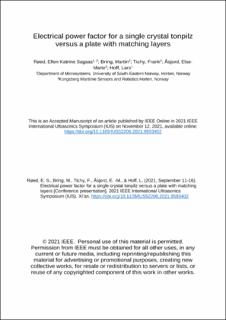| dc.contributor.author | Røed, Ellen Katrine Sagaas | |
| dc.contributor.author | Bring, Martin | |
| dc.contributor.author | Tichy, Frank | |
| dc.contributor.author | Åsjord, Else-Marie | |
| dc.contributor.author | Hoff, Lars | |
| dc.date.accessioned | 2022-08-05T07:56:06Z | |
| dc.date.available | 2022-08-05T07:56:06Z | |
| dc.date.created | 2021-11-04T09:41:12Z | |
| dc.date.issued | 2021 | |
| dc.identifier.citation | Røed, E. S., Bring, M., Tichy, F., Åsjord, E. -M., & Hoff, L. (2021, September 11-16). Electrical power factor for a single crystal tonpilz versus a plate with matching layers [Conference presentation]. 2021 IEEE International Ultrasonics Symposium (IUS). Xi’an. | en_US |
| dc.identifier.issn | 1948-5719 | |
| dc.identifier.uri | https://hdl.handle.net/11250/3010248 | |
| dc.description.abstract | For underwater transducers mounted on small platforms, reactive electrical power can constitute a main restriction on the usable frequency range. The frequency range in which the amount of reactive power is acceptable can be increased by increasing the electromechanical coupling coefficient of the active material. However, to avoid large electrical power factor ripple, the transducer design must also have a low mechanical quality factor, Qm. A ferroelectric single crystal can have electromechanical coupling coefficient k=0.9. The optimum Qm is then as low as 0.6, which is challenging to achieve. We investigated this challenge for a tonpilz design, by calculating Qm for different combinations of head masses and tonpilz stiffnesses, and by calculating the stiffness to density ratio required in the head material to avoid flexural resonances. The effective coupling coefficient of a real transducer is reduced compared to the material coupling coefficient, and in many applications some power factor ripple can be accepted. Both factors relax the Qm requirement. We calculated the power factor of a tonpilz design with k=0.82 and Qm=1.9, and showed that the power factor ripple is smaller than 0.2 in a frequency band that is 150 % wide relative to the resonance frequency. The frequency independent matching inherent in the tonpilz gives this design an advantage regarding power factor ripple, and this can weigh up for a large Qm. We showed this by comparing the tonpilz to an air-backed composite plate. Like the tonpilz, the composite plate had k=0.82, but it was matched to water by two conventional acoustic matching layers. Compared to the tonpilz, the composite design had a larger distance between the −3dB points of the acoustic power. Beyond these points, the acoustic power was however falling off more rapidly, resulting in an electrical power factor ripple of nearly 0.5. | en_US |
| dc.language.iso | eng | en_US |
| dc.title | Electrical power factor for a single crystal tonpilz versus a plate with matching layers | en_US |
| dc.type | Peer reviewed | en_US |
| dc.type | Journal article | en_US |
| dc.description.version | acceptedVersion | en_US |
| dc.rights.holder | © 2021 IEEE. | en_US |
| dc.source.pagenumber | 4 | en_US |
| dc.source.journal | Proceedings - IEEE Ultrasonics Symposium | en_US |
| dc.identifier.doi | https://doi.org/10.1109/IUS52206.2021.9593402 | |
| dc.identifier.cristin | 1951292 | |
| dc.relation.project | Norges forskningsråd: 237887 | en_US |
| dc.relation.project | Norges forskningsråd: 290462 | en_US |
| cristin.ispublished | true | |
| cristin.fulltext | postprint | |
| cristin.qualitycode | 1 | |
